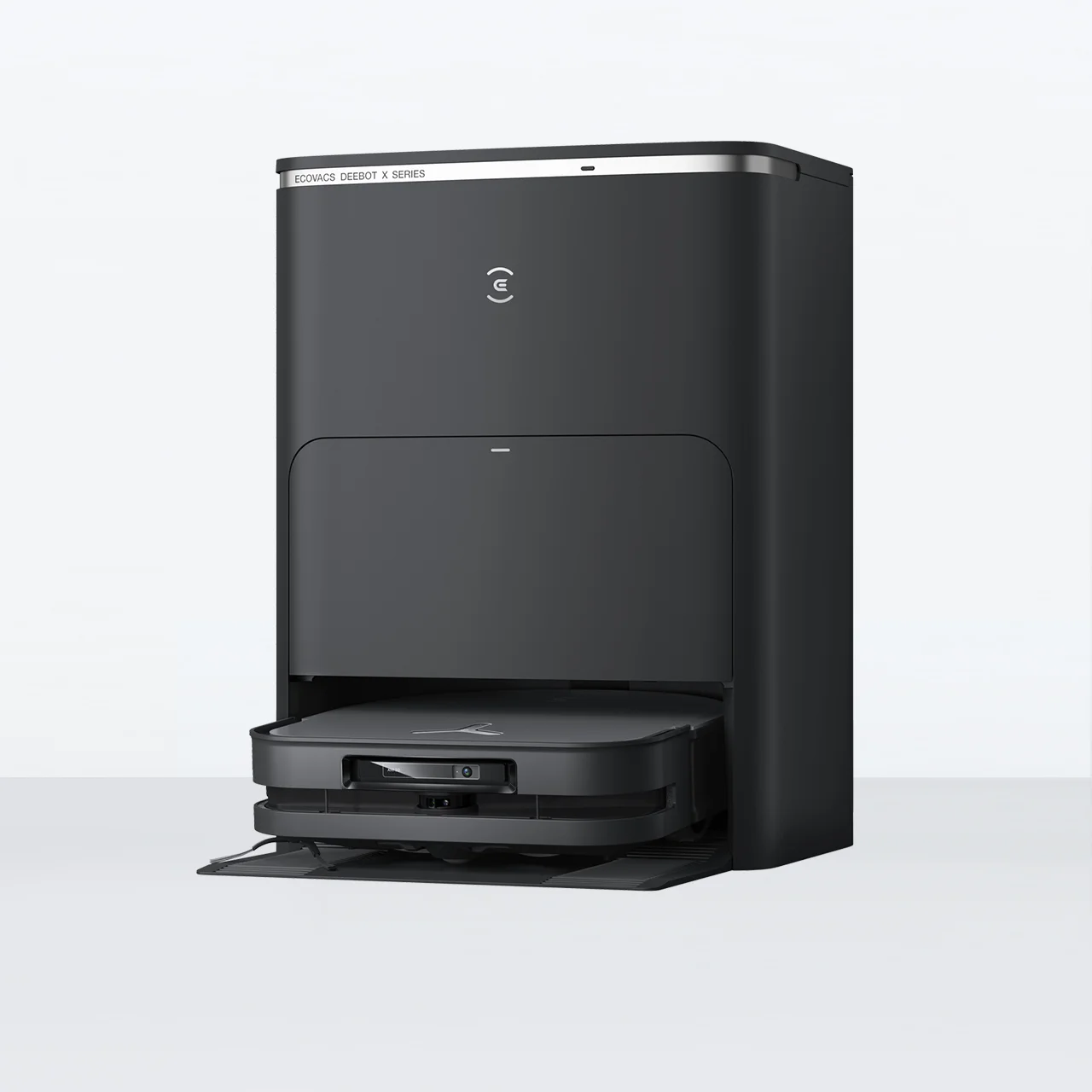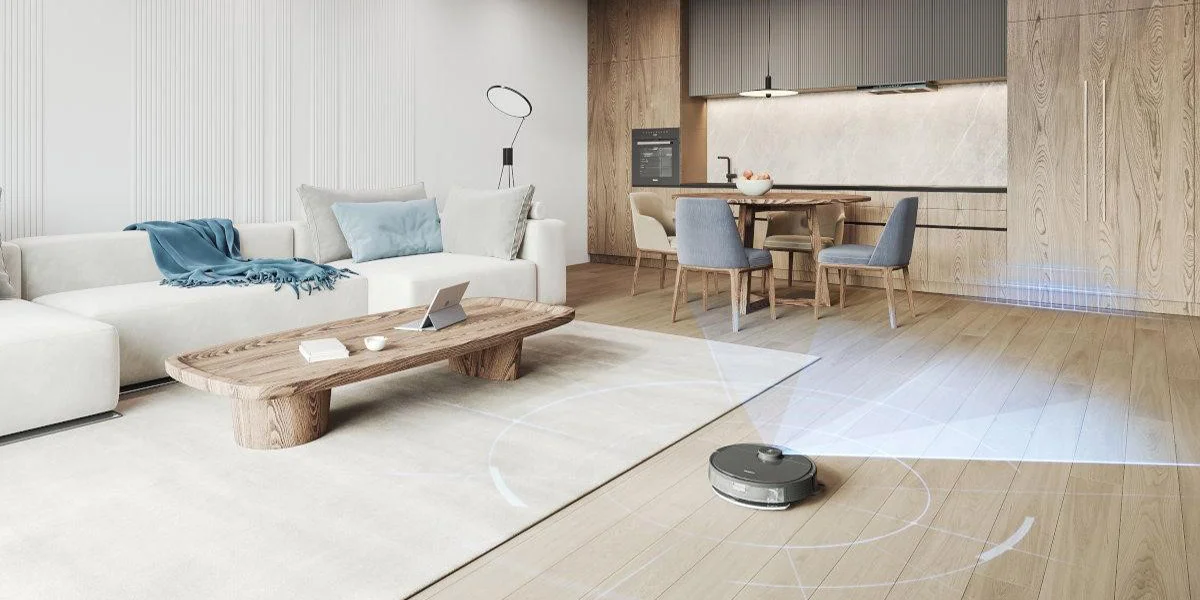
Robotic vacuums have come a long way from their early days of bumping into furniture and navigating randomly. Fast-forward to today, while standard models rely on infrared sensors for obstacle detection, robot vacuums with built-in cameras enhance AI-powered visual recognition to identify objects, map rooms and adapt their cleaning paths in real-life scenarios more efficiently. Overall, this means fewer missed spots and a smarter, more strategic clean.
Do All Robot Vacuums Have Cameras?
Not all smart vacuums use cameras – some rely on LiDAR or infrared sensors, while others combine cameras with LiDAR for better navigation. A camera helps detect obstacles and map rooms more accurately. Recent DEEBOT models have advanced cameras, making cleaning easier by avoiding obstacles and adjusting if you rearrange furniture or add new items.
Robot vacuums with cameras improve navigation and efficiency compared to those without. Compared to traditional models that rely solely on sensors, these robots can visually recognise objects like power cords, pet bowls and furniture legs. This means fewer collisions with furniture and better adaptability to changes in your home. For instance, DEEBOT’s built-in HD cameras work alongside AI-powered algorithms to extract information about the environment, from detecting walls and furniture, to differentiating between types of debris on the floor, and planning optimised cleaning paths.
Many wonder, can an auto vacuum with a camera serve as security? While it’s not a full security system, it can provide live video streaming, letting users check their homes remotely. This is useful for monitoring pets, deliveries or movement when away. However, it lacks features like alarms or motion alerts, so it’s best as a complement, not a replacement, for home security.
Best DEEBOT Robot Vacuums with Cameras
DEEBOT X8 PRO OMNI

As a flagship model in the DEEBOT X series, DEEBOT X8 PRO OMNI delivers powerful vacuuming and mopping with AI-enhanced features. Its OZMO ROLLER Instant Self-Washing Mopping Technology scrubs at 200 RPM to remove stains while continuously rinsing the mop to prevent bacteria buildup. Meanwhile, its 18,000 Pa suction power1 lifts debris across various floor types, while ZeroTangle 2.0 technology saves you from removing tangled hair from the brushes.
DEEBOT X8 PRO OMNI further comes with Video Manager in the ECOVACS HOME app. This feature lets users live stream from the robot’s camera, check preset home areas like cat beds or back doors, and even make real-time video calls with the elderly at home.
Shop DEEBOT X8 PRO OMNI NowDEEBOT T50 PRO OMNI

Only 81mm in height, the slim auto vacuum, DEEBOT T50 PRO OMNI, is equipped with world-class navigation system for optimised cleaning coverage. Its dToF LiDAR, 3D structured light, and AI-powered RGB cameras navigate precisely even in dark areas; while the TruEdge 2.0 Adaptive Edge Cleaning system extends the side brush dynamically for 100% corner-to-corner coverage2. Moreover, AIVI 3D 3.0 OMNI-Approach Technology improves real-time object recognition and avoidance, allowing it to clean around obstacles instead of avoiding them entirely.
For added security, the Video Manager function supports live video streaming and two-way communication, giving you peace of mind when checking on pets, deliveries, or specific spots at home.
Shop DEEBOT T50 PRO OMNI NowDEEBOT X5 PRO OMNI

Another model from the X series is DEEBOT X5 PRO OMNI, which stands out with its advanced AINA 2.0 Intelligent Navigation Model. Under this technology, the vacuum recognises furniture, rooms and objects with remarkable precision. Its AIVI 3D 2.0 technology, paired with a 960P starlight-level camera and RGBD sensors, strengthens navigation and reduces cleaning disruptions.
To handle the complex indoor environment at home, the Real-Time Path Planning system adapts to moving furniture or new obstacles, ensuring efficient cleaning; while AI Instant Re-Mop and Intelligent Deep Mopping detect tough stains like soy sauce and automatically adjust water output, making multiple passes for deep cleaning. In addition, the camera of the vacuum supports the Video Manager function for live monitoring, keeping you and your family connected no matter where you are.
Shop DEEBOT X5 PRO OMNI NowWhy Choose a Robot Vacuum With a Camera?
Robot vacuums use cameras to enhance data aggregation for a more detailed understanding of the environment. So, if you live in a compact space, have a lot of furniture, or simply want a vacuum with more precise navigation, a camera-equipped model can make the cleaning process smoother and more efficient.

Improved Navigation & Mapping
Auto vacuums with cameras better understand their position within your home’s layout. They use visual images and localisation sensors to determine their orientation. By capturing images of obstacles in their path, they gather a rich cache of information for mapping and therefore, they can navigate more freely.
Accurate Obstacle Detection
Another major advantage of robot vacuum with cameras is superior obstacle recognition. These cameras can be pointed in one direction or provide a 360-degree view, helping the vacuum distinguish between objects, like identifying the difference between a sock and pet waste.
Smart vacuums like DEEBOT X8 family and T50 family are trained with extensive image datasets to recognise up to 30 household objects3. With AIVI 3D 3.0 OMNI-Approach Technology, the machine clean around obstacles instead of staying away from them entirely.
Real-time Environmental Analysis
With a camera, robot vacuums can analyse and adapt to environmental changes in real time. Over weeks and months, as furniture moves or new objects appear, AI-powered vacuums learn and adjust accordingly. Daily situation such as children leaving toys scattered around after playtime, can be recognised and accounted for. The longer a vacuum operates in a home, the faster and more efficiently it cleans.
Remote Home Monitoring
Finally, robotic vacuum cleaners with cameras double as mobile home security devices while away. Certain DEEBOT robot vacuums with cameras offer Video Manager via the ECOVACS HOME app, where you can live video stream and check on your pets or your loved ones while you're out.
How ECOVACS Innovates in Camera Technology
ECOVACS has continuously refined its camera technology to overcome common limitations found in smart vacuums. From low-light navigation to accurate obstacle detection and real-time adaptability, ECOVACS models integrate advanced AI-powered recognition and multi-sensor technology to ensure seamless performance.
Low-Light Navigation
One of the primary challenges of camera-based navigation is low-light performance. Without adequate lighting, standard cameras struggle to capture clear images. However, ECOVACS robots address this by pairing cameras with ToF (Time-of-Flight) and 3D structured light sensors, so they can navigate in dark spaces as normally as in well-lit conditions.
Intelligent Obstacle Interpretation
Another challenge for robot vacuums is detecting glass doors, mirrors, and clear plastic barriers. ECOVACS solves this with multi-sensor technology, combining 3D imaging, ultrasonic sensors, and LiDAR to build a complete understanding of the space. Even if one camera misinterprets a transparent surface, other sensors compensate to prevent collisions.
Advanced AI Recognition
Although not all DEEBOTs are equipped with cameras, those that do use AI recognition, i.e. AIVI technology, to help differentiate between everyday objects like shoes and pet toys from dirt and debris that need to be cleared out, minimising errors. With this technology, you don’t need to intervene even in a busy household.
Real-Time Learning
Homes change, and we are not only talking about layout and furniture moves but also new messes, such as dog poop or dirty clothes on the floor that appear daily. The DEEBOT X8 family and T50 family address this with real-time learning capabilities, meaning they don’t just rely on pre-mapped layouts; instead, they continuously update their maps and improve navigation around obstacles over time.
Enhanced User Control
ECOVACS further enhances user control with the cameras on its robotic vacuums. With the Video Manager feature on the ECOVACS HOME app, users can monitor their home in real time via the robot’s built-in camera, whether sending the machine to a specific spot or performing a patrol in preset locations. The app also allows users to customise cleaning settings, set no-go zones, and communicate with the YIKO voice assistant for specific commands.
FAQ
Do robot vacuums have cameras?
Not all smart vacuums have cameras, but the ones that do use cameras to enhance navigation and obstacle detection. The sophicated models often combined with AI and multiple sensors for improved mapping.
Do robot vacuums take pictures?
Vacuum robots with cameras can capture images to be used for image processing purposes, which help the device navigate your home more efficiently and accurately avoid more types of common domestic obstacles.
What do robot vacuum cameras do?
Robot vacuum cameras are just one of many technologies that your smart cleaning device can utilise to ‘see’ and ‘learn’ your home. Cameras help the robot understand their location in relation to your house’s layout, analyze the environment as it changes in real time, better detect and recognise foreign objects and even allow users to see a video feed of their home from the robot’s perspective.
Disclaimer(s):
- 18,000Pa: This data comes from ECOVACS laboratory. The suction power of DEEBOT X8 PRO OMNI can reach 18,000Pa.
- 100% Cleaning Coverage: This data refers to that the sweeping function of ECOVACS DEEBOT X8 Family products can achieve 100% sweeping coverage at outer corners and inner corners in the experimental scenario. The data is from the ECOVACS laboratory. Specific results are subject to actual home use.
Related Products









